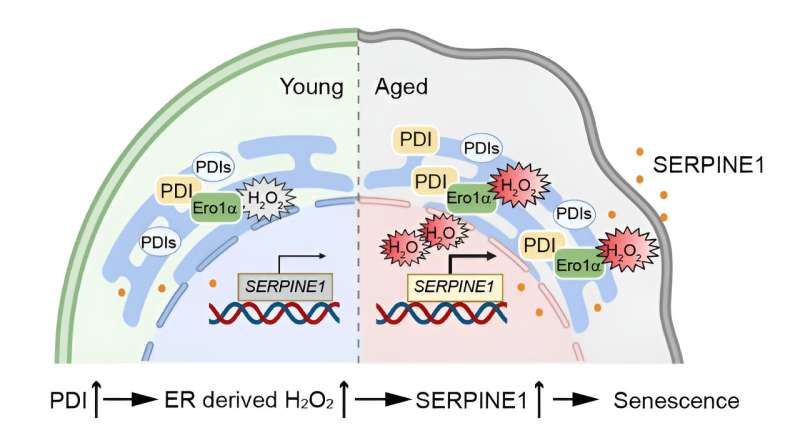This article has been reviewed according to Science X's editorial process and policies. Editors have highlighted the following attributes while ensuring the content's credibility:
fact-checked
peer-reviewed publication
trusted source
proofread
Researchers reveal role of protein oxidative folding in stem cell aging

It has been widely acknowledged for a long time that mitochondrion is the main source of reactive oxygen species (ROS). The role of the endoplasmic reticulum (ER)-generated ROS has been less extensively studied. It has been proposed that oxidative protein folding contributes approximately 25% of cellular ROS during protein synthesis. Thus, the ER-derived ROS cannot be ignored. Yet the role of the ER-derived ROS in the regulation of stem cell senescence remains unknown.
Prof. Wang Lei and Wang Chih-chen's group at the Institute of Biophysics (IBP) of the Chinese Academy of Science and Prof. Liu Guanghui's group at the Institute of Zoology, CAS jointly published a research article on Aug. 3 in EMBO reports, titled "Reducing oxidative protein folding alleviates senescence by minimizing ER-to-nucleus H2O2 release."
The study established the relationship between oxidative protein folding and stem cell aging for the first time. It was observed that H2O2 generated by oxidative protein folding in the ER can be released to the nucleus, therefore induced the expression of SERPINE1, a key factor promoting cell senescence.
The researchers found that protein disulfide isomerase (PDI), a key oxidoreductase that catalyzes oxidative protein folding, accumulated in aged human cells and the liver of mice, and depletion of PDI alleviated cell senescence. By using an ultra-sensitive, genetically encoded fluorescence probe, researchers futher showed that PDI deficiency slowed the rate of oxidative protein folding and reduced the level of its byproduct H2O2 both in the ER and the nucleus.
Through omics analysis, researchers found that PDI deficiency causes the downregulation of SERPINE1, an aging-related molecule regulated by H2O2, thereby alleviating the senescence of stem cells.
Researchers also showed that knockdown of PDI in various human cell models can delay senescence, indicating that PDI may be a potential molecular target for alleviating aging.
Previous studies have revealed that reducing the transcription and protein synthesis alleviate senescence. This study provides new ideas and molecular targets for understanding aging from the perspective of protein folding, implying that in order to achieve sustainable development of individuals (younger), cells should also improve energy efficiency and emission reduction (reducing oxidative protein folding).
More information: Fang Cheng et al, Reducing oxidative protein folding alleviates senescence by minimizing ER‐to‐nucleus H2O2 release, EMBO reports (2023). DOI: 10.15252/embr.202256439
Journal information: EMBO Reports
Provided by Chinese Academy of Sciences



















